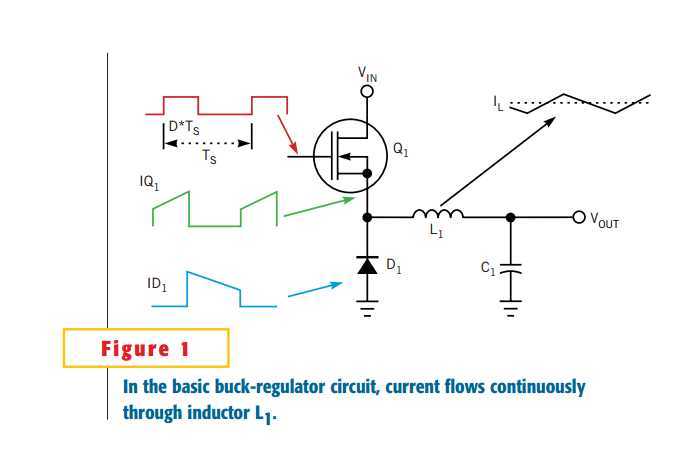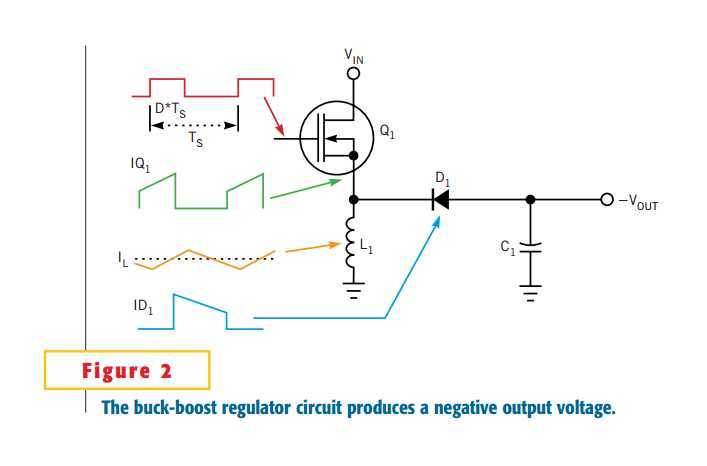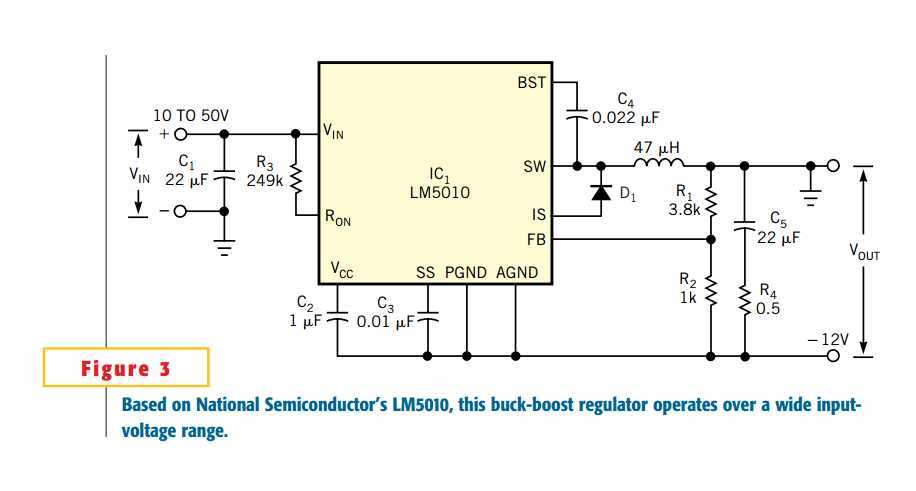标签:des blog http io ar os sp for on
Buck regulators find wide application as step-down regulators for converting large positive input voltages into a smaller positive output voltages. Figure 1 shows a simplified buck regulator that operates in continuous-conduction mode—that is, the inductor current always remains positive. The output voltage, VOUT, is equal to D×VIN, where D is the duty-cycle ratio of the buck switch, Q1, and VIN is the input voltage. The duty cycle, D, is equal to TON/TS, where TON is the on-time of Q1 and TS is the switching-frequency period.
You can reconfigure a buck regulator into a buck-boost circuit to convert a positive voltage into a negative voltage (Figure 2). The basic component configurations of both circuits are similar, and the inductor and the rectifier diode are transposed. Because the main switch, Q1, remains in the same location for both configurations, you can use an IC buck regulator for either topology. Switching on Q1 applies input voltage VIN across power inductor L1, and current in the inductor ramps up while Q1remains on. When Q1 switches off, inductor current continues to flow through C1, the load resistance and D1, producing a negative output voltage. During Q1‘s next on-time interval, the output capacitor supplies current to the load.
Figure 3 shows a low-cost buck-boost converter based on the LM5010 buck-regulator IC that converts a 10 to 50V positive supply voltage into –12V. Although many applications use a fixed switching frequency and modulate the output pulse width, this design features a constant-on-time approach in which the IC‘s internal output transistor turns on for an interval that‘s inversely proportional to the difference between the circuit‘s input and output voltage.
Inside IC1, a regulation comparator monitors the output voltage from voltage divider R1 and R2 and a 2.5V internal reference, and, if the output voltage falls below the desired value, the comparator switches on IC1‘s output transistor for an interval that an on-timer determines:

Providing that current through L1 remains continuous, VOUT remains regulated. Because R3 and K are constants, switching frequency FS remains constant. This relationship holds true provided that the current through the inductor remains continuous. At lighter loading, the current in the inductor becomes discontinuous—that is, the inductor current drops to zero for a portion of the switching cycle. At the onset of discontinuous operation, the switching frequency begins to drop and thus brings VOUT back into regulation.
Operating a buck-boost regulator in fixed-frequency mode without an oscillator eliminates loop compensation and stabilization components and, as a bonus, offers fast transient response unlimited by feedback-network lag time. With the component values in Figure 3, the regulator operates at approximately 400 kHz, delivering 12V at approximately 0.5A for 10V input and approximately 1A of output current for 50V input. Resistor R4 ensures that the minimum amount of output-ripple voltage necessary for regulation—approximately 25 mV—is available.
Fixed-frequency operation without an oscillator offers a low-cost, easily implemented regulator with no loop-compensation or stability issues to worry about. The transient response is fast, because there are no bandwidth-limiting feedback components. The regulator operates at approximately 400 kHz. The output-current capability varies with the input voltage. When you apply 10V input voltage, the output-current capability is approximately 0.5A, and, at 50V input, the output current is approximately 1A.



Constant-on-time buck-boost regulator converts a positive input to a negative output
标签:des blog http io ar os sp for on
原文地址:http://www.cnblogs.com/shangdawei/p/4128233.html